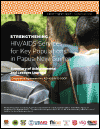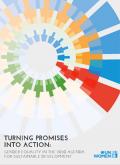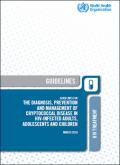What's New
Displaying results 1571 - 1580 of 4899

Resource | Publications,
The Strengthening HIV/AIDS Services for Key Populations in Papua New Guinea project generated an end of project series in three parts. The summary document presents results, success stories, recommendations and lessons learned. The second document shows the relationship between gender-based violence and HIV in the country and looks at the benefits of integrating clinical services. The third document is a set of annexes to the step-by-step process of integrating gender-based violence services with HIV services.

Resource | Guidelines,
These new guidelines supersede previous WHO policy documents on the management of Latent TB Infection (LTBI) in people living with HIV, household contacts of people with active TB, other groups at risk of developing TB, and for LTBI testing. The consolidated guidelines are expected to provide the basis and rationale for the development of national guidelines for LTBI management, adapted to the national and local epidemiology of TB, the availability of resources, the health infrastructure and other national and local determinants.

Resource | Presentations,
New data confirm that the practice of child marriage has continued to decline around the world, with accelerated progress in the last 10 years. Progress is insufficient to meet the ambitious target of elimination, as set forth in the SDGs.
The global number of child brides is now estimated at 650 million. The number of girls married in childhood each year, according to the latest prevalence and population figures is estimated at 12 million.

Resource | Publications,
This regional lessons-learned report provides insight into what is involved in undertaking primary prevention of VAWG and what both drives its success and hinders its progress. These lessons aim to inform organizations and agencies involved in, or that plan to become involved in, primary prevention programming, to assist in their planning and budgeting and for donors to gain insight into the costs and complexities of primary prevention work.

Resource | Publications,
"Turning Promises into Action: Gender Equality in the 2030 Agenda for Sustainable Development", UN Women's new flagship report, provides a comprehensive and authoritative assessment of progress, gaps and challenges in the implementation of the Sustainable Development Goals (SDGs) from a gender perspective. The report monitors global and regional trends in achieving the SDGs for women and girls based on available data, and provides practical guidance for the implementation of gender-responsive policies and accountability processes.

Resource | Guidelines,
These guidelines provide recommendations and good practice guidance on the optimal approach to diagnosing cryptococcal meningitis, strategies for preventing invasive cryptococcal disease through cryptococcal antigen screening and pre-emptive fluconazole therapy, treating cryptococcal meningitis with combination antifungal therapy regimens, preventing, monitoring and managing amphotericin B drug toxicity, recommendations against adjunctive therapy with systemic corticosteroids and recommendations on the timing of antiretroviral therapy (ART) initiation.

Resource | Publications,
Increasing advocacy and efforts to address childhood tuberculosis (TB) at global and country levels have brought the child and adolescent TB epidemic into the spotlight. Building on global strategies, the first Roadmap for childhood tuberculosis: towards zero deaths was developed by WHO and partners, under the guidance of the then Childhood TB Subgroup, and published in October 2013. The 2013 Roadmap laid out the strategic framework for the fight against childhood TB, aiming for zero TB deaths among children, highlighting ten key actions and the enhanced investment needed to address childhood TB.
This document compiles examples of best practices at global, regional and country levels since the launch of the first edition of the Roadmap. It describes 36 examples from 24 countries (including 10 TB, two multidrug-resistant TB (MDR-TB) and four TB/ human immunodeficiency virus (HIV) high burden countries) from all the six WHO regions, two regional initiatives and 12 global initiatives. The examples are categorized according to the ten key actions from the 2013 Roadmap.

Resource | Publications,
The 2018 United Nations General Assembly High-Level Meeting (HLM) on Tuberculosis and the current revision of the Roadmap for childhood tuberculosis together present an important moment to consolidate and advance advocacy, commitment, resource mobilization and joint efforts by all stakeholders to provide health care and address the burden of TB among children

Resource | Tools,
Each year we commemorate World TB Day on March 24 to raise public awareness about the devastating health, social and economic impact of tuberculosis (TB) and urge acceleration of efforts to end the global TB epidemic. The aim of this campaign, starting on 19 March, the week of the World TB Day date, is to build overarching commitment and leadership at the highest level to End TB.
Despite significant progress over the last decades, TB continues to be the top infectious killer worldwide, claiming over 4500 lives a day. The emergence of drug-resistant TB (DR-TB) poses a major health threat and could put at risk gains made in efforts to end TB.

Resource | Publications,
The Global Health 50/50 Report provides a benchmark across the sector to catalyse shifts in organisational and management culture and practice, the adoption of gender-responsive policies, and ensuring adequate resources for programmes focusing on the gendered dynamics of global health. It seeks to provide evidence of where the gaps lie while shining a light on ways forward.





